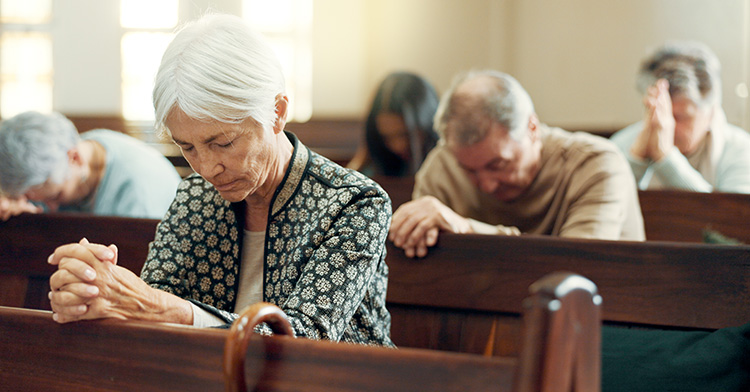Every week, pastors wrestle with Scripture. They pore over ancient texts, searching for meaning, looking for a relevant word to bring to their parishioners.
But for some pastors -- often those still new to a church -- the complexities of scriptural exegesis pale in comparison to the mystery confronting them when they set foot in the pulpit: the congregation. Looking out, they may wonder: “Who in the world are these people?”
Though most pastors are equipped to interpret a text, they don’t know how to “exegete” a congregation, said Nora Tubbs Tisdale, professor of homiletics at Yale Divinity School and author of “Preaching as Local Theology and Folk Art.”
“Congregations really are like biblical texts, filled with layers of meaning,” Tisdale said. If pastors are to practice ministry in a way that is meaningful to a local community of faith, they must first understand that community, Tisdale said.
Questions to consider:
- What are the most powerful and revealing signs and symbols of your congregation’s life together?
- How are the members of your congregation like you? How are they different from you? How do you challenge the assumption that you know them?
- What are effective ways for the silent stories to be exegeted? Should they be?
- What are the similarities and differences between exegeting a congregation and exegeting a biblical text?
The need for such skills is a growing concern for denominational officials, especially those who supervise young pastors. While most pastors come to understand their congregations, that knowledge is usually acquired haphazardly, by trial and error, often at a high cost.
“It is increasingly an issue,” said the Rev. Gray Southern, superintendent for the Durham, N.C., district of the United Methodist Church. “There is often a lack of understanding that when a pastor arrives in a community, it has a culture of its own that precedes him or her, and the pastor has work to do to understand it.”
Gray still winces when he recounts the story of a well-intended student pastor who preached to his rural N.C. congregation on the virtues of veganism, which he considered the only authentic Christian diet. In a community that loved barbecue and valued hunting and farming with a sense of sacredness and stewardship, that was a sermon that “didn’t preach.”
The Rev. Dr. G. Wilson Gunn Jr., general presbyter for the National Capital Presbytery, which serves the Washington, D.C., region, said the inability to understand a congregation even may prompt some to leave ministry.
“This is perhaps the single shortfall that leads to pastoral departures, especially for folks just out of seminary,” he said. This fall, the presbytery will launch a facilitated group, required for pastors who have been ordained less than five years, to address the issue of understanding a congregation’s “story.”
Formation and transformation
In a world where pastors may feel pressured to use the latest gimmick to achieve success, some may be tempted to see congregational exegesis as a marketing technique, another way for pastors to boost popularity and exercise control.
But the only acceptable reason for understanding a congregation and its context is theological, experts say.
“It’s because you believe that God is interested in human beings as they actually are,” said James R. Nieman, professor of practical theology and specialist in homiletics at Hartford Institute for Religion Research. “It’s because God is interested in encountering us where we exist. We need to understand the place where people exist so that encounter can happen.”
Nieman, like Tisdale, is one of several scholars who study and write about contextual preaching and ministry. He has reservations about the “exegesis” metaphor, preferring instead the language of “context.”
He cautions that when a congregation is imagined as a text to be read, it easily can become an object, a thing subject to manipulation. Knowing a congregation’s context is not about finding “clever things to say that will appeal to them,” said Nieman, author of “Knowing the Context: Frames, Tools and Signs for Preaching.”
Terminology aside, he agrees with Tisdale, who says that Christian ministry and worship are about formation and transformation. Pastoral ministry must be fitting for a particular congregation, but also transformative.
“If we as preachers are going to proclaim the gospel in ways capable of transforming congregational identity, we first need to become better acquainted with the ways in which our people already imagine God and the world,” Tisdale wrote in “Preaching as Local Theology and Folk Art.”
To do that, the pastor must gather as much information as possible, sift it and interpret it, much like an anthropologist or ethnographer studying a new culture, Tisdale said.
The process begins with a “listening heart,” she said.
“It is the notion that you go in with an attitude that says ‘I’m open to learning from you, so teach me,’” Tisdale said. “It’s the attitude that you’re going into a context not to fix someone, but to listen and learn, to understand them more deeply as a brother or sister in Christ.”
Both Tisdale and Nieman were alerted to the importance of congregational analysis early in their careers.
Serving four churches in rural Virginia right out of seminary, Tisdale ran head-on into culture shock. Sermons that would fly in one congregation would bomb in another. Though the churches virtually were indistinguishable demographically, each was unique.
For Nieman, the cultural gap was even more profound. In his second pastoral appointment, he served a congregation of Iñupiaq Lutherans in Anchorage, Alaska.
“It was so abundantly clear that we were so completely different that you got shaken out of the assumption that we know each other,” he said. “We all make that assumption so often when we meet someone and start a conversation, but of course, we don’t really know each other at all.”
Knowing he needed help, Nieman studied the book “Constructing Local Theologies” by Robert Scherieter.
“As I began paying more attention to contextual questions in that congregation in Alaska, I realized that similar things had been going on in my first congregation in Iowa where everybody looked and sounded like me,” he said. “That extreme in Alaska helped me realize these were tools for any place.”
Seven symbols
Many signs and symbols can be used to enhance a pastor’s understanding. In “Preaching as Local Theology and Folk Art,” Nora Tubbs Tisdale recommends starting with the following:
- Stories and interviews
- Archival materials
- Demographics
- Architecture and visual arts
- Rituals
- Events and activities
- People, both the leaders and those on the margins
Clues to the mystery
Few pastors will encounter an artifact that speaks as clearly as the one the Rev. Ed Moore found when he arrived at his first church in a rapidly changing part of Maryland, more than 20 years ago: The front door was painted shut and had not been opened for years.
For a declining United Methodist Church in a once-thriving textile-mill town, now surrounded by suburban sprawl, the closed door was a powerful statement, said Moore, now the director of educational programs for the Clergy Health Initiative at Duke Divinity School.
“It was a symbol of their fear,” Moore said. “They felt culturally threatened and keeping the front doors locked was their way of saying, ‘Don’t take our story away.’”
But in other contexts, the pastors will have to work harder. Even the silences -- the stories congregations don’t like to talk about -- can be revealing. But those usually take a long time and the development of deep trust before they are divulged, Tisdale said.
Creating a congregational timeline can be a particularly fruitful exercise for pastor and parishioners, suggested Jack Carroll, Williams Professor Emeritus of Religion and Society at Duke Divinity School.
“Get a group together over a potluck supper and have them talk about what was going on in the church, decade by decade,” he said. “Ask them to put that in context of the broader community and society and they will start making all sorts of connections. It can give enormous insight to a pastor.”
In her book, Tisdale lists seven “symbols for congregational exegesis,” particularly promising areas of inquiry, including stories and interviews, archival materials, demographics, architecture and visual art, rituals and events.
“Almost anything that comes your way may be revelatory,” Tisdale said. “The fun for me is that you can start anywhere. What are the favorite hymns people like to sing? What’s on the bulletin boards? What are the church’s demographics and what do people think they are?”
Generally, though, there are no shortcuts, no simple ways to read and understand a congregation, Carroll said.
“It’s mainly observing and listening,” he said. “You’re observing and listening all the time, but then you have to step back and figure out what does this all mean? Am I seeing any patterns?”
Nieman recommends a pastor first narrow the focus by defining a particular issue. Maybe it’s how decisions are made or how conflict is managed. Congregations are complex organizations with history, subgroups and intricate power relationships. Trying to understand it all can be overwhelming, so the pastor must decide what to pay attention to, he said.
“The challenge is how to get on board in a way that isn’t a full-time job,” Nieman said. “You’re not called to be an anthropologist. You’re called to be a pastor, so you’re called to know the context in a smart way.”
In addition to defining a particular issue, a pastor should identify the strongest symbols and signs for this group of people.
“What are the things that point out how they speak of God or the other gods that dominate them?” he said. “Sometimes it’s not the God of the Bible, but money, power, fear, shame or race. How do you get to know what the local gods are?”
What can grow here?
The goal of all this, of course, is to use the accumulated knowledge to shape ministry.
The Rev. George Mason, pastor of Wilshire Baptist Church in Dallas, Texas, said the next step is envisioning the possibilities for the church's future.
“Almost every church is resistant to a new pastor coming in with an agenda that is not organic to the church’s life,” he said. “The question the pastor has to answer is ‘What is organic to this church’s life?’ Once I know what the soil is, then I can know what can grow here.”
Sometimes the lessons are obvious: The student pastor who preached on veganism quickly learned the importance of understanding a congregation. Moore had a carpenter pry open his church’s sealed door. More importantly, he knew immediately his ministry should focus on helping the church cope with a changing world.
Pastors also have to realize that this process is not a guaranteed path to exciting, productive ministry. Sometimes the pastor discovers the soil is depleted, even barren.
“There can be an idealism in pastoral ministry that we’re going to turn this around and everybody in the church is going to become mission-minded, worldly, engaged Christians,” Nieman said. “But sometimes just getting them to stop being afraid and angry may be the best you can do.”
It may take generations to get a once-active congregation to focus on mission again, Nieman said. A pastor might even conclude that he or she is not a good match for a congregation. But here, too, contextual knowledge can help answer that question and help pastors accept their own limitations, Nieman said.
Pastors are called to be faithful in proclaiming the gospel, meet people where they are and be present in times of sorrow and joy, interpreting the seasons of life in ways that are consonant with Christ, Nieman said.
They are not called to manage congregants’ lives or to be liked by them. Even in listening to a sermon, parishioners have work to do as well, taking its message and making something of it in their lives, Nieman said.
“It takes a certain amount of courage for a pastor to realize that ministry is not all about me,” Nieman said. “It may be easier to stay afraid and stay the jester rather than be the pastor. But it’s liberating to say, ‘It’s not my responsibility to live your Christian life.’”















